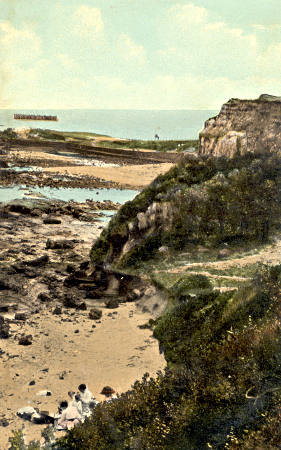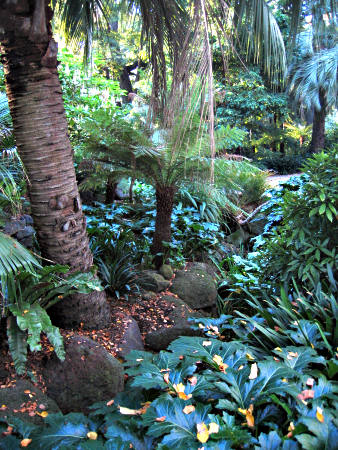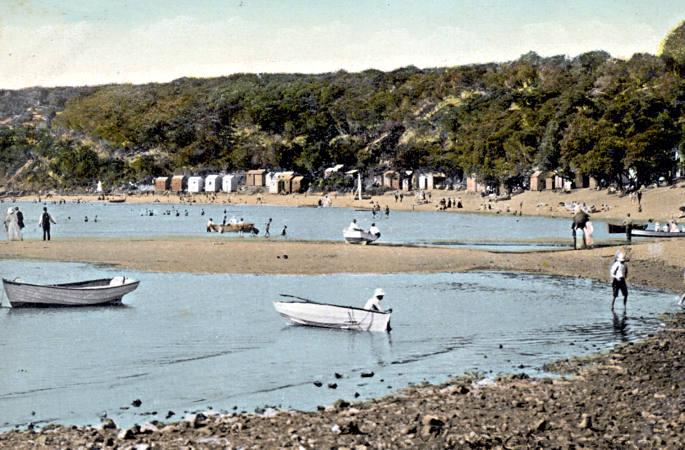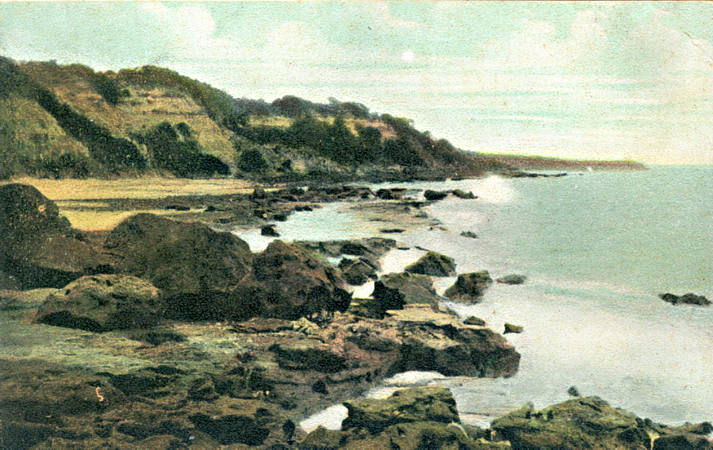Protecting the Environment

Cliffs at Half Moon Bay, c1920. Courtesy: Prudence Grieve.
The protection of the Port Phillip Bay foreshore has been a concern of Melbourne’s residents over many years. [1] In 1884 a letter to the Brighton Southern Cross by local solicitor, David Abbott challenged the lawfulness of the Moorabbin Shire Council’s proposal to remove stone and rocks from the beach at Picnic Point and Half-Moon Bay. Abbott claimed the shire council was destroying sections of the foreshore sparking a rigorous response by the Shire President and Shire Secretary.

David Abbott.
This account commences with a council report published in the Brighton Southern Cross of February 2, 1884. The report said the Moorabbin Shire Council had let a contract to make the road to the jetty at Picnic Point using stone mined from the Point. Abbott, responding to this report in a letter to Council, pointed out that a few years earlier one hundred yards (91m.) of Picnic Point had been washed away because stone and rock had been removed to beautify the Fitzroy, Treasury and Carlton Gardens. Agitation at that time caused the Government to issue a proclamation ( July 23,1877) prohibiting the removal of stone and rock from the foreshore or from Crown Land within one chain (20 m) of high water mark. In defiance of that order, Abbott claimed, the Council had authorised its contractor to remove stone to construct a road that benefited the Shire President. He suggested about 300 loads had already been removed. To gain this material a road had been cut into the embankment for one quarter of a mile (approx. 400m) destroying a large quantity of ti-tree and good-sized honey suckle trees. Local fishermen, Abbott reported, also had concerns. With damage to the Point, their sole safe refuge between Sandringham and Mordialloc was threatened.

Fitzroy Gardens, Melbourne, 2008.
Abbott concluded his letter by expressing the hope that the President and the other two West Riding representatives on the Council would be opposed at the first opportunity. [2] Otherwise, he suggested, their places could be filled by others ‘…who will take a greater interest in the protection and preservation of the most valuable part of the West Riding.’
The editor of the Brighton Southern Cross in his editorial drew attention to Abbott’s letter pointing out that the destruction of the stone banks along with the covering ti-tree and honeysuckle defaced the picturesque nature of the area and opened up properties to the devastating effects of wind, waves and sand. He advised the Council that one piece of land should not be destroyed to improve another, and lamented the failure of the Council to apprehend individuals who ‘laid low’ half an acre [100 sq. m] of ti-tree on the best part of the beach opposite Occupation Road. [3]
Abbott’s letter and the editorial brought two sharp responses in the paper’s next edition. Charles Mock, Shire President, a resident of Half-Moon Bay for twenty-four years, expressed the view that no damage had been done to the Bay. While he agreed some stone and rock had been removed for road making, he considered that any damage caused to the location was due to high tides and strong southerly winds. He believed thousands of tons of material could be gained there without doing any harm.

Half Moon Bay. Courtesy Prudence Grieve.
He was apologetic about the road to be built passed his residence, but did not think it was necessary for Mr Abbott to make an issue of this – considering the attention given over many years by the Council to Picnic Point, the place of Abbott’s residence. Mock continued that it was the first direct benefit he personally had received. He went on to justify the actions of council. Bluestone was too costly. Gravel was scarce and expensive, yet there were copious amounts of stone lying at their door. He asked, because a few neighbours wanted the stone to remain in the sea ‘to grow winkles, limpets and mussels were others to go without roads where they were not already made?’
John Keys, Shire Secretary and local Member of Parliament, commenced his letter with the comment that he had neither the time nor inclination to enter into a newspaper controversy. But he felt it necessary to respond to the Abbott letter and the paper’s editorial. For Keys, the editor should have known better, since he had attended council meetings for years hearing councillors taking actions to protect the foreshore. Keys reminded readers that it was the council that stopped the wholesale destruction of the ti-tree by offering a ‘handsome’ reward of £5 for information leading to prosecution of those engaging in the illegal act. [4]
Keys agreed that he had authorised the contractor at Half Moon Bay to remove the stone from below the high water mark. However, this was only after receiving the necessary written permission from the ‘only person having the power to give it.’ It was also true, he acknowledged, that the Council had let a contract for road construction to the jetty at Picnic Point from loose shingles from below the high water mark. ‘Surely,’ Keys asked, ‘there is nothing wrong with that? His letter concluded with a ‘threat’ that if Picnic Point residents did not desire the road to be built the money saved could be used’ on some other road which was of more advantage to the ratepayers generally.’ [5]

Rocks at Sandringham Beach, c1900. Courtesy Jean Martin.
David Abbott’s response in the next edition of the Brighton Southern Cross took up almost three columns. At time sarcastic, it also reflected his knowledge of the law. He quoted from the 1877 proclamation, ‘. . . no person, although he may be duly licensed or otherwise authorised, shall remove stone, gravel, loam, brick or other earth, from the foreshore of Port Phillip Bay, or from any Crown land situate within a distance of one chain from high water mark in the said bay.’ Abbott pointed out that given this direction the authorisation the Council claimed to have received from ‘a person with power to give it’, was not worth the paper on which it was written. Abbott also directed Mock and Keys’ attention to a letter received by Council from the Lands Department. In this they were informed of the Proclamation regarding removal of stone and rock. In addition, he pointed to correspondence from the Lands Department dated December 19, 1879 refusing a request from the Council to take stone from the beach, quoting the Proclamation as the reason the request was denied. This evidence, Abbott claimed, substantiated his comment in his first published letter that the Council had acted in defiance of regulations in taking the stone from Half Moon Bay. [6]
Regarding damage caused to the foreshore by the removal of stone and rock, Abbott drew upon the reports of two experts. One, Surveyor Munro, writing in 1877, said that the disintegration of the land appeared to have occurred in the previous two or three years. He had no doubt that it had been caused mainly by the disturbance and removal of rocks. The rocks, he said, had protected the headland from the violence of the sea. The second authority was Yeomans, the Crown Lands Bailiff. He commented that the Council should not be allowed to touch one stone at Picnic Point, for ‘if it is once allowed, in a few years that verdant and much frequented spot will be a thing of the past.’ Abbott added that it was common sense that if the rock and stone forming the foreshore were taken away, the resistance to waves would also be lost. The bank would then naturally fall.
As for the construction of roads, Abbott was positively inclined. He had property along the beach. With the construction of roads it would increase in value. However, to take stone from the beach to make the roads he contended was robbing ‘Peter to pay Paul’. He believed there was plenty of gravel available if the Council was prepared to pay a fair price. Alternatively, he suggested, it could buy an acre of quarry land at Williamstown for £100 and gain sufficient stone to supply the whole shire for several years.
Of Shire Secretary Key’s letter he wrote, ‘I think I should have felt somewhat annoyed at the tone of his letter had it not been for the dear old phrase with which he commenced it, viz., I have neither the time nor the inclination.’ He goes on to suggest that Keys’ letter to the Customs Department for permission to remove ‘loose shingle below the high water mark on the foreshore’ was a little misleading as he knew that some thousands of loads of stone would have had to be taken to construct the proposed road. If the Customs Department knew that stone was to be quarried, Abbott believed permission would never have been granted as it was illegal (given the 1877 proclamation). [7]
David Abbott concluded his letter with the comment, ‘I sincerely hope I have not said in this letter anything to offend Mr Keys. I do not forget that he is a member of Parliament, and I tremble for the safety of our dear old beach when I think of that horrible spectre, the accursed, baneful, all powerful political influence. Oh, dear Mr Shire secretary, dear Mr Shire engineer, I will forgive you for everything you have said, done, and omitted to do, if you will keep the member from the back stairs of the public offices!’ [8]
At the meeting of Moorabbin Shire Council on March 10, 1884 a further letter from David Abbott was read detailing the injury that was being done to the foreshore by removing stone and rock. He offered to pay half the cost of the gravel for the road or, if his offer was refused, he advised that the National Land Company was willing to donate the gravel. At least two Councillors commented on the letter. Cr Ward said the endeavour of the Council was always to protect the foreshore and suggested a hole would have greater effect in breaking the waves than a rock. He proposed that the Council should seek a deputation with the Commissioner of Customs to discuss the matter. Cr Bent was opposed to the idea, saying that he had inspected the beach and confirmed Abbott’s report. He was surprised at the extent of the damage at Picnic Point. The road to the pier opposite the Duke of Edinburgh `Hotel had been cleared of ti-tree for up to forty feet (12 m) in some places and the wood sold for firewood. He also found that stone was being quarried out of the banks, a situation he could not tolerate. If the removal of stone injured the beach – he for one would go strongly to stop it. The councillors resolved to visit the beach and draw their own conclusions. [9]
Shire Secretary Keys chose not to reply publicly to David Abbott, retiring from the field, no doubt feeling a little mauled.
However this was not the end of the issue. The Brighton Southern Cross printed a satirical poem written in larrikin dialect by ‘Pleeceman X’ purporting to have been published in the Melbourne Punch that summed up the matter. [10]
Witch the shire they call Moorabbyn.
Must ha’ verry careless grown,
When contractors took to grabbin’
The beaches nat’ral stoan.
But a hi was on the road, sires,
And David Abbott swore,
Him effeckt, ‘May I be bolde sires,
Hif tghey have this stone no more.’
‘Thoe approved of by the Shire,
It’s a most illegal act –
I cann scarce keep down my ire;
I can’t and that’s a fack.
What though Moorabbyn’s shire
Is a large and mighty thing,
E’en a jihant like Golire
Found a David who could sling.
‘Thoe the President may muster
Curridge at mi frage to Mock,
Thoe Kays M.P., may bluster,
He can’t open a dead-lock
Hour hansom beach teo grab it
His 2 much of sorrer’s cup,
They had bewair the abbott
Wen ‘e’s gott his monk-ee up.’
So the Abbott from ‘is convent
Purseeded spots to knock
From guilty ones – and on vent
To run a George a-Mock.
The shire-engineer some sneezers
Did the legal Abbott punch,
Till it seemed a case of Keys, sirs,
Knocked all up of a bunch.
Wieth hit’s gen’rally conceded,
The Abbott won the fite,
And moast folks are glad that he did,
For his caws and law wos rite.
The sheir shood make its duty
To protect each ‘point’ and ‘reach’
Witch forms the nat’ral beauty
Of deer old Brighton Beech.
Footnotes
- For issues of concern to residents in the 1970s see: Whitehead, G. J, Mentone Clay Cliffs and Whitehead, G. J, No Pipe Line Across the Bay: respectively http://localhistory.kingston.vic.gov.au/htm/article/312.htm, and http://localhistory.kingston.vic.gov.au/htm/article/318.htm.
- The municipality was divided into three areas called ridings; East West and Central. The West Riding included Hampton, Black Rock and Beaumaris.
- Brighton Southern Cross, February 16, 1884.
- Brighton Southern Cross, February 23, 1884.
- Brighton Southern Cross, February 23, 1884.
- Brighton Southern Cross, March 1, 1884.
- Brighton Southern Cross, March 1, 1884.
- Brighton Southern Cross, March 1, 1884.
- Brighton Southern Cross, March 15, 1884.
- Reprinted in Southern Cross, March 22, 1884. Issues of Melbourne Punch for March 1884 have been searched to identify the actual date of publication – to no avail. The identity of ‘Pleeceman X’ remains a mystery. Could ‘Pleeceman X’ have been a pseudonym of David Abbott, or a pen name for one of the reporters of the Brighton Southern Cross – or even its editor?
